Sampling in Text Generation
This tutorial is the fourth part of the “Text Generation in Deep Learning with Tensorflow & Keras” tutorial series. In this series, we have been covering all the topics related to Text Generation with sample implementations in Python.
In this tutorial, we will focus on how to sample (select) the next token in Text Generation. First, we will introduce the text generation process. Then, we will briefly present the most common methods of sampling. Afterward, we will implement three sampling methods: Greedy Sampling, Temperature Sampling, and Top-k sampling. We will discuss the advantages and disadvantages of these methods as well. Thus, in the end, we will understand the sampling in Text Generation and prepare the implementation of three popular sampling methods to use in upcoming parts for word-level text generation.
You can access to all parts of the Deep Learning with Tensorflow & Keras Series at my blog muratlkarakaya.net. You can watch all these parts on the Murat Karakaya Akademi YouTube channel in ENGLISH or TURKISH. You can access the complete Python Keras codes in the video description of each part.
If you would like to learn more about Deep Learning with practical coding examples, please subscribe to Murat Karakaya Akademi YouTube Channel or follow my blog on muratkarakaya.net. Do not forget to turn on notifications so that you will be notified when new parts are uploaded.
If you are ready, let’s get started!
Photo by Brett Jordan on Unsplash
I assume that you have already watched all the previous parts. Please ensure that you have reviewed the previous parts in order to utilize this part better.
You can watch this notebook for more verbal explanations.
What is Text Generation?
A Language Model (LM) can be trained to generate text word-by-word or character-by-character.
The input and output sequences given to the LM are made of tokens that are either a word or a character.
In training, we supply a sequence of tokens as input (X) and a target token (next token to complete the input) as output (y)
After training, the Language Model learns to generate a conditional probability distribution over the vocabulary of tokens according to the given input sequence.
Below, you see a word-level LM predicts a conditional probability distribution over the word dictionary for the given word sequences “I want to cook”
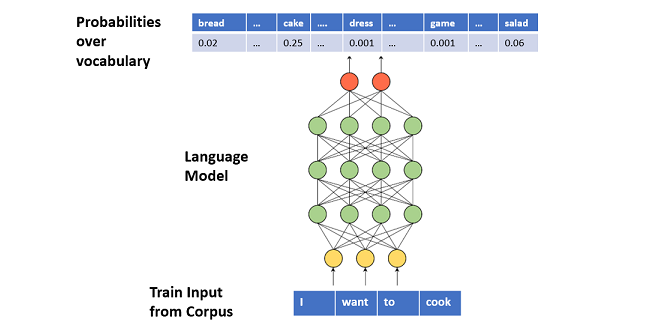
To generate text, we can iterate over the below steps:
- Step 1: we provide a sequence of words to the Language Model as input
- Step 2: the Language Model outputs a conditional probability distribution over the vocabulary
- Step 3: we sample a word from the distribution
- Step 4: we concatenate the newly sampled word to the generated text
- Step 4: a new input sequence is generated by appending the newly sampled word
For more details, please check Part A, B, and C.
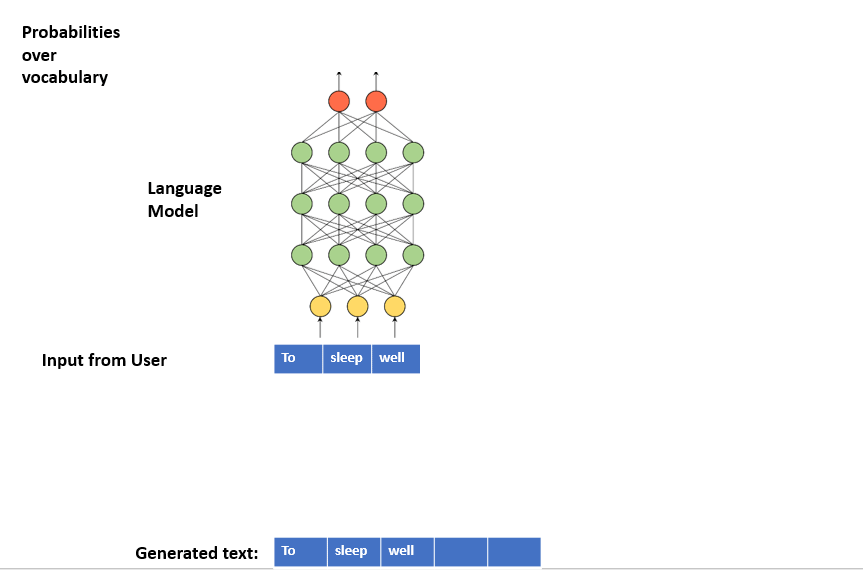
Sampling
In Text Generation, sampling means randomly picking the next token according to the generated conditional probability distribution.
That is, after generating the conditional probability distribution over the set of tokens (vocabulary) for the given input sequence, we need to carefully decide how to select the next token (sample) from this distribution.
There are several methods for sampling in text generation (see here and here):
- Greedy Search (Maximization)
- Temperature Sampling
- Top-K Sampling
- Top-P Sampling (Nucleus sampling)
- Beam Search
In this tutorial, we will code Greedy Search, Temperature Sampling, and Top-K Sampling.
In the end of the tutorial, I will introduce the Top-P Sampling and Beam Search briefly.
1. TRAIN A LANGUAGE MODEL
In this tutorial, since we are more interested in sampling methods and their implementations, we will simulate the conditional probability distribution over the token vocabulary by assuming that:
- We opt to generate text character-by-character.
- We have a vocabulary of characters from ‘a’ to ‘z’.
- We have already trained the Language Model with a corpus.
- Thus, the Language Model is ready to generate a conditional probability distribution over the token vocabulary for a given input sequence.
- Now, we want to sample (select) the next token from the conditional probability distribution.
Let’s prepare the simulated LM.
Define the vocabulary
dictionary =[]
for c in range(ord('a'), ord('z')+1):
dictionary.append(chr(c))
dictionary['a',
'b',
'c',
'd',
'e',
'f',
'g',
'h',
'i',
'j',
'k',
'l',
'm',
'n',
'o',
'p',
'q',
'r',
's',
't',
'u',
'v',
'w',
'x',
'y',
'z']
Simulate the trained LM:
class language_model:
def __init__(self, dictionary):
self.dictionary = dictionary
def predict(self):
output= np.random.rand(len(dictionary))
output=output/output.sum()
return output
model=language_model(dictionary)Simulate the generation of the conditional probability distribution:
predictions= model.predict()
plt.bar(dictionary,predictions)
plt.show()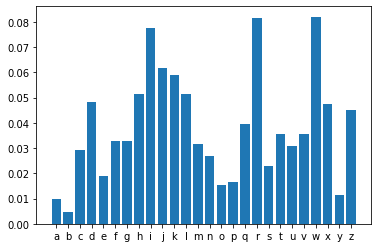
predictions.sum()1.0
Now, we can code several sampling methods and observe their behaviors.
2. SAMPLING BY GREEDY SEARCH
Greedy search simply selects the token with the highest probability as its next word.
However, if we always sample the most likely word, the standard language model training objective causes us to get stuck in loops like “I don’t know. I don’t know. I don’t know.”
def greedy_search(conditional_probability):
return (np.argmax(conditional_probability))next_token = greedy_search(predictions)
print("Sampled token: ",dictionary[next_token])Sampled token: w
3. TEMPERATURE SAMPLING:
Temperature sampling is inspired by statistical thermodynamics, where high temperature means low energy states are more likely encountered.
In probability models, logits play the role of energy and we can implement temperature sampling by dividing logits by the temperature before feeding them into softmax and obtaining our sampling probabilities.
Below is an implementation for Temperature Sampling taken from here
3.1 Drawing from the model a probability distribution over the next character given the text available so far
plt.bar(dictionary,predictions)
plt.show()
3.2 Reweighting the distribution to a certain “temperature”
temperature=0.2
conditional_probability = np.asarray(predictions).astype("float64")
conditional_probability = np.log(conditional_probability) / temperature
plt.bar(dictionary,conditional_probability)
plt.show()
3.3 We can apply the softmax function. Remember that the softmax function is:
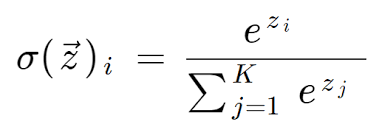
exp_preds = np.exp(conditional_probability)
conditional_probability = exp_preds / np.sum(exp_preds)
plt.bar(dictionary,conditional_probability)
plt.show()
3.4 Sampling the next character at random according to the reweighted distribution
probas = np.random.multinomial(1, conditional_probability, 1)
plt.bar(dictionary,np.squeeze(probas))
plt.show()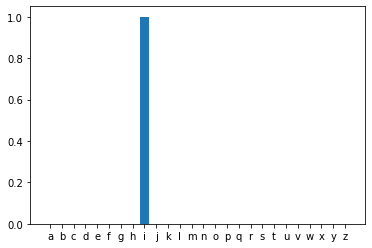
3.5 Put all the steps together as a function
def temperature_sampling (conditional_probability, temperature=1.0):
conditional_probability = np.asarray(conditional_probability).astype("float64")
conditional_probability = np.log(conditional_probability) / temperature
exp_preds = np.exp(conditional_probability)
conditional_probability = exp_preds / np.sum(exp_preds)
probas = np.random.multinomial(1, conditional_probability, 1)
plt.bar(dictionary,conditional_probability)
plt.show()
return np.argmax(probas)Note that the model predicts the below conditional probability distribution over the vocabulary
plt.bar(dictionary,predictions)
plt.show()
After applying temperature sampling with different temperature values, we have the following updated conditional probability distributions over the vocabulary for the given temperature values:
for temp in np.arange(0.2,1.6,0.2):
print("Temperature: ", temp)
next_token = temperature_sampling(predictions, temperature=temp)
print("Sampled token: ",dictionary[next_token])Temperature: 0.2

Sampled token: w
Temperature: 0.4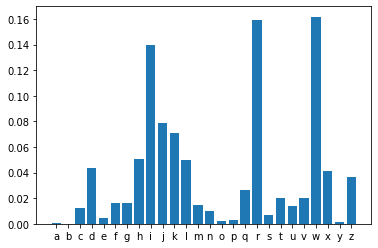
Sampled token: h
Temperature: 0.6000000000000001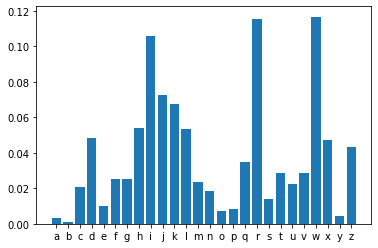
Sampled token: z
Temperature: 0.8
Sampled token: w
Temperature: 1.0
Sampled token: f
Temperature: 1.2
Sampled token: i
Temperature: 1.4000000000000001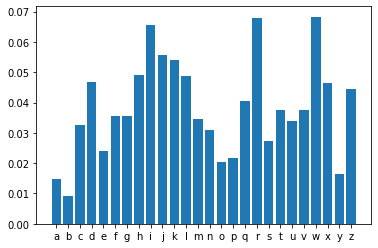
Sampled token: m3.6 Observations
In most of the researches, it is noted that:
- Low-temperature results in extremely repetitive and predictable text, but where the local structure is highly realistic: in particular, all words (a word being a local pattern of characters) are real words from the corpus.
- With higher temperatures, the generated text becomes more interesting, surprising, even creative; it may sometimes invent completely new words that sound somewhat plausible.
- With a high temperature, the local structure starts breaking down and most words look like semi-random strings of characters.
- Always experiment with multiple temperature values! A clever balance between learned structure and randomness is what makes generation interesting.
4. TOP-K SAMPLING
Fan et. al (2018) introduced a simple, but very powerful sampling scheme, called Top-K sampling. In Top-K sampling, the K most likely next words are filtered and the probability mass is redistributed among only those K next words. GPT2 adopted this sampling scheme, which was one of the reasons for its success in story generation.
To apply the Top-k sampling, we sort all the tokens according to the probabilities and zeroing out the probabilities for anything below the k’th token.
4.1 Let’s have a conditional probability distribution over the dictionary.
predictions= model.predict()
plt.bar(dictionary,predictions)
plt.show()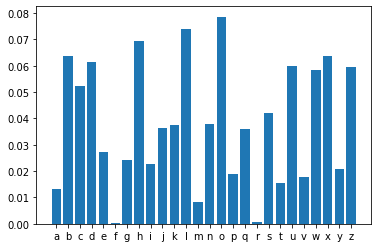
4.2 Select the top-k probabilities
We can use tf.math.top_k() function to find the k largest entries in the vector and outputs their values and indices as vectors.
Using the indices, we can record the token names for plotting names of the tokens.
k=5
top_k_probabilities, top_k_indices= tf.math.top_k(predictions, k=k, sorted=True)
top_k_indices = np.asarray(top_k_indices).astype("int32")
top_k_tokens=[dictionary[i] for i in top_k_indices]
top_k_indices, top_k_tokens(array([14, 11, 7, 23, 1], dtype=int32), ['o', 'l', 'h', 'x', 'b'])
4.3 We can apply the softmax function on these tokens
top_k_redistributed_probability=softmax(np.log(top_k_probabilities))
top_k_redistributed_probability = np.asarray(top_k_redistributed_probability).astype("float32")
print('top_k_tokens: ',top_k_tokens)
print('top_k_redistributed_probability: ',top_k_redistributed_probability)
print('Total probability: ', top_k_redistributed_probability.sum())top_k_tokens: ['o', 'l', 'h', 'x', 'b']
top_k_redistributed_probability: [0.22512405 0.21178281 0.19833136 0.1825569 0.18220489]
Total probability: 1.0plt.bar(top_k_tokens,top_k_redistributed_probability)
plt.show()

4.4 Sampling the next character randomly according to the reweighted distribution
sampled_token = np.random.choice(top_k_indices, p=top_k_redistributed_probability)
print("Sampled token id: ",sampled_token, " token: ",dictionary[sampled_token])Sampled token id: 11 token: l
4.5 Put all the steps together as a function
def top_k_sampling(conditional_probability, k):
top_k_probabilities, top_k_indices= tf.math.top_k(predictions, k=k, sorted=True)
top_k_indices = np.asarray(top_k_indices).astype("int32")
top_k_redistributed_probability=softmax(np.log(top_k_probabilities))
top_k_redistributed_probability = np.asarray(top_k_redistributed_probability).astype("float32")
sampled_token = np.random.choice(top_k_indices, p=top_k_redistributed_probability)
top_k_tokens=[dictionary[i] for i in top_k_indices]
plt.bar(top_k_tokens,top_k_redistributed_probability)
plt.show()
return sampled_tokenLet’s remember the predictions from the model once more:
predictions= model.predict()
plt.bar(dictionary,predictions)
plt.show()
4.6 After applying top-k sampling with different k values
We have the following updated conditional probability distributions over the vocabulary for the given k values:
for k in range (5, 25, 5):
next_token = top_k_sampling(predictions, k=k)
print("k: ", k)
print("Sampled token: ",dictionary[next_token],"\n")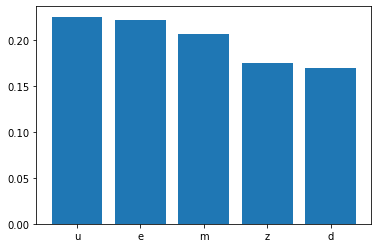
k: 5
Sampled token: u
k: 10
Sampled token: n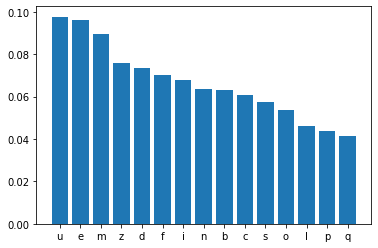
k: 15
Sampled token: e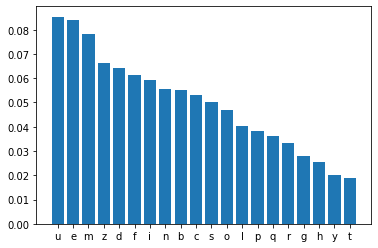
k: 20
Sampled token: z4.7 Observations
In the studies, it is reported that the top-k sampling appears to improve quality by removing the tail and making it less likely to go off-topic.
However in some cases,
- there really are many tokens we could sample from reasonably (broad distribution), and
- in some cases, there are few tokens (narrow distribution).
Therefore, the k value should be chosen carefully.
5. OTHER SAMPLING METHODS
There are many other methods proposed for sampling. The ones below are the most common. I live the implementation of them to you as an exercise :)
- Top-P Sampling (Nucleus sampling): Another way to exclude very low probability tokens is to include the most probable tokens that make up the “nucleus” of the probability mass function (PMF), such that the sum of the most probable tokens just reaches p. In other words, based on a parameter 0<=p<=1, Top-P Sampling aggregates the smallest set of words that have summed probability mass p. It can be thought of as a variation of top-k sampling with dynamic k. For details check this blog.
- Beam Search: Beam search reduces the risk of missing hidden high probability token sequences by keeping the most likely num_beams of hypotheses at each time step and eventually choosing the hypothesis that has the overall highest probability. For details check this blog and that one.
- Beam search will always find an output sequence with a higher probability than greedy search but is not guaranteed to find the most likely output.
CONCLUSION:
In this tutorial, we discussed sampling in text generation and codded three sampling methods.
We also discussed the pros and cons of these methods.
In general, it is advised to experiment with multiple sampling methods.
Moreover, it is a good idea to set the parameters of these models such that a balance between learned structure and randomness is created.
In this way, we can expect to generate an interesting text.
If you’d like, you can implement the Top-P Sampling and Beam Search by yourself.
In the next parts, we will see how to put together the data pipeline and sampling to create a Text Generation model. Please keep following for the upcoming parts:
- Part E: Recurrent Neural Network (LSTM) Model for Character Level Text Generation
- Part F: Encoder-Decoder Model for Character Level Text Generation
- Part G: Recurrent Neural Network (LSTM) Model for Word Level Text Generation
- Part H: Encoder-Decoder Model for Word Level Text Generation
Comments or Questions?
Please share your Comments or Questions.
Thank you in advance.
Do not forget to check out the next parts!
Take care!
References
tf.data: Build TensorFlow input pipelines
Text classification from scratch
Working with Keras preprocessing layers
Character-level text generation with LSTM
Toward Controlled Generation of Text
What is the difference between word-based and char-based text generation RNNs?
The survey: Text generation models in deep learning
Generative Adversarial Networks for Text Generation
FGGAN: Feature-Guiding Generative Adversarial Networks for Text Generation
How to sample from language models
How to generate text: using different decoding methods for language generation with Transformers
Hierarchical Neural Story Generation
How to sample from language models
A guide to language model sampling in AllenNLP
Generating text from the language model
How to Implement a Beam Search Decoder for Natural Language Processing

